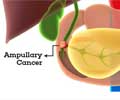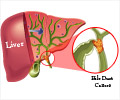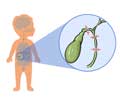The use of temporary fully covered self-expanding metal stents can effectively fix a severely blocked or narrowed bile duct, according to a multi-center analysis.

Narrowing or blockage of a bile duct can lead to the dangerous leakage of bile into the body's organs and bloodstream. Bile is a necessary fluid produced by the liver that assists in the body's digestive process. Bile ducts are the series of thin, connected tubes that transport bile from the liver through the body to the small intestines. Patients who experience a bile duct stricture may experience jaundice, severe pain, itchiness, weight-loss, elevated liver function tests, cirrhosis and liver failure over a period of a few weeks.
Biliary strictures can be cancerous or benign. A benign stricture can occur as a result of surgical injury or trauma, pancreas inflammation, scarring or hardening of bile duct tissue caused by chronic inflammation, recurrent gallstones or poor reconnection of tissues post-liver transplantation. A biliary stricture is often diagnosed with explorative endoscopy -- a procedure that uses a thin flexible camera probe to hunt for blockages, CT imaging or MRI.
Surgery once played a pivotal role in the management of benign biliary strictures, but it's associated with significant complications and mortality. Today, minimally invasive endoscopic stent placement has emerged as a less invasive and more successful therapeutic option.
Only permanent plastic stents are currently FDA approved for benign stricture indications. However, these plastic stents involve multiple endoscopic procedures and multiple large stents. Also, plastic stents are often associated with stent blockages and failure of long-term durable results for stricture resolution.
FCSEMS are being tested in patients with benign biliary strictures to overcome the limitations of plastic stents, and the complications of their uncovered or semi-covered metal stent counterparts. The fully covered membrane design of FCSEMS prevents embedding and ingrowth of the stent into the bile duct's wall.
Advertisement
This study is the first to analyze the safety and efficiency of these implanted metal stents for benign stricture resolution after their removal. "The study showed the majority of patients who received a metal stent had symptom relief, negative imaging for stricture and no need for repeat stent replacement except the patients who underwent liver transplant," says Dr. Kahaleh.
Advertisement
"Fully covered self-expanding metal stents are emerging as a promising therapeutic option in the treatment of benign bile duct strictures," Dr. Kahaleh says. "We found very acceptable, high rates of stricture resolution after the use and removal of metal stents in all types of patients groups. Also, those with longer duration of stent placement that didn't migrate had an increased likelihood of stricture resolution."
Current data and the FDA support the use of plastic stents in the endoscopic treatment of benign bile duct blockages. However, this current research study reports previous plastic stenting doesn't always hold up. In fact, the study shows failed plastic stenting had been performed in more than half of the study patients who underwent implant of metal stents. Also, researchers report previous plastic stenting was associated with a decreased rate of stricture resolution.
"It's time to revisit the therapeutic options we offer our patients for this often sudden and painful benign bile duct narrowing and blockages," says Dr. Kahaleh. "Our study shows that any type of benign biliary stricture except those related to liver transplant can be treated with these metal stents, and metal stents may just do a better job fixing benign strictures then plastic stents."
The researchers report FCSEMS did have some minor complications in the patient population studied. After implantation, complications included stent migration (10.5 percent), post-procedural pain requiring hospital admission (6 percent), pancreatitis (2 percent) and stent occlusion (3 percent). Also, minimal stent removal complications included mild bleeding (1 percent), unraveling of the stent (2 percent) and hyperplastic reaction (1 percent).
According to the research team, further research investigation of FCSEMS is necessary in a prospective, multi-center randomized control trial to assess the long-term efficacy of these metal stents with a more than three-month average period of stent indwelling time.
Source-Eurekalert














